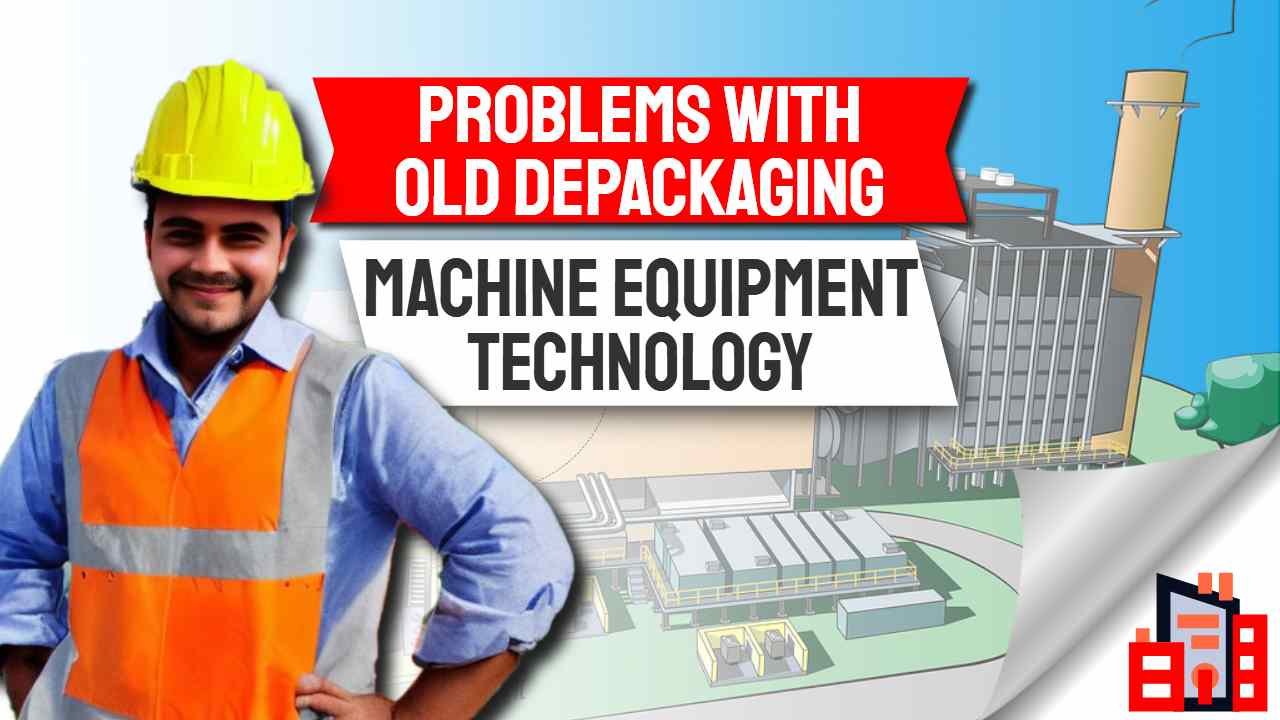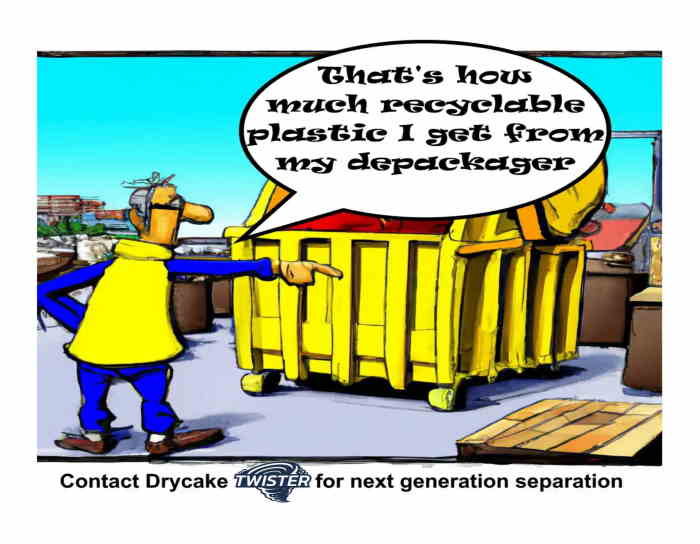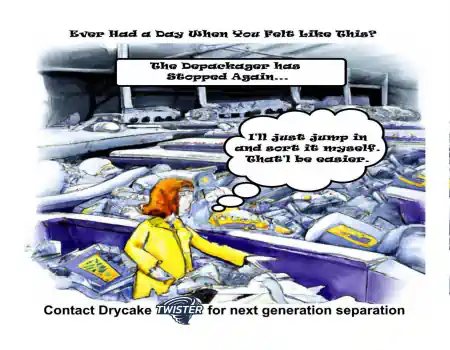Problems with Depackaging Machine Equipment Technology
by DepackJoe
Posted on 14-01-2023 02:01 AM

Depackaging machine equipment technology is a crucial aspect of waste management and recycling, but operating this equipment is frequently problematic. These machines are designed to separate all types of food and organic waste and packaging materials and should make it easier to recycle or compost organic waste. However, many issues can arise with the use of these machines, which can lead to costly downtime and a decrease in the overall efficiency of the recycling process or the ability to recycle plastics at all. This article discusses the various problems associated with depackaging machine equipment technology, including poor reliability, large footprints, damage by large and heavy unexpected objects, high energy use, and long delivery times on spare parts.
It also highlights the examples of machines that fail to provide an optimized pulp for use to feed anaerobic digesters and those that produce a reject stream output that is not suitable for recycling and must be sent to a landfill.
Depackaging Machine Equipment Technology - Often Described as Costly to Run and Unreliable
These machines are designed to separate food waste and packaging materials, making it easier to recycle or compost the organic waste and yet are often criticised by their users as costly and unreliable. They are nowhere near as reliable as the equipment used in other industries, and users often complain that they have to make do and mend this equipment far more than is common in other industries.

Operational Issues with Currently Used First-Generation Depackaging Machine Equipment Technology
Several issues can arise with the use of these machines, which can lead to costly downtime and a decrease in the overall efficiency of the recycling process. One of the main problems with depackaging machine equipment technology is poor reliability. Many machines are prone to breakdowns and stoppages in recycling lines and can suffer from:
- bearing failures,
- clogging and blocking, and
- damage by foreign bodies (unexpected objects) in OFMSW, kitchen waste, and source-segregated waste.
This can lead to long periods of downtime while repairs are carried out, which can be costly for recycling companies.
Large Footprint of Depackaging Equipment
Another problem with depackaging machine equipment is the large footprint of the equipment, which includes complicated feed and output conveyor systems. These systems can be prone to stopping due to flexible plastic that gets wound around conveyor parts and plastic films (e.g. plastic bags). This can lead to delays and reduced efficiency in the recycling process.
Damage by Large and Heavy Unexpected Objects
Furthermore, depackaging machines can be damaged by large and heavy unexpected objects, jamming the moving parts of waste shredders, hammermills, and rotary paddle systems. This can result in costly downtime while repairs are carried out.
High Energy Use
Additionally, with overcomplicated systems these machines require high energy use, which can lead to expensive energy bills, especially now that energy prices have risen to an all-time high due to the Russian invasion of Ukraine and the cutting of natural gas supplies from Russia.
Long Delivery Times on Spare Parts
Long delivery times on spare parts, especially since the covid pandemic, can be a problem when repairs are needed.
Poor Performance when Required to Provide an Optimized Pulp Content for Anaerobic Digesters
In addition to these problems, some depackaging machines fail to provide an optimized pulp for use to feed anaerobic digesters and produce a reject stream output that is a "mess of plastic" and "a smelly organic content" and "organic food still stuck to the plastic particles" in the reject material making it unsuitable for recycling and condemning the recycling company to have to pay for the "rejects" output to be sent to a landfill.
Depackaging Machines are Hard to Clean or Need a Lot of Cleaning
Lastly, most depackaging machines are hard to clean or need a lot of cleaning, which can take a lot of time and resources.
High Levels of Attendance for Machines Marketed as Automatic
Some even require constant attendance to watch for foreign objects as the hopper delivers the feed into the depackaging system, lest objects jam and damage the machinery. This is not only unhealthy and menial work, but it can also be dangerous if an attendant is tempted to lean into moving machinery to remove offending objects to avoid costly stoppages of the line while such items are removed.
Why is Old Depackaging Technology so Poor?
It's easy to understand that there was no incentive to develop better equipment until recently. The development of waste depackaging and separation equipment has been a slow process until recent years due to a lack of demand while the value of recyclates has remained low since China ceased to accept the west's poor quality recyclable materials at the start of 2018.
Until the last 5 or so years, the market for waste depackaging and separation equipment has been depressed, meaning that there was little justification for manufacturers and suppliers to invest in developing new organic waste pretreatment technology.

As a result, they simply modified the existing equipment ranges to improve its performance for waste depackaging and separation of all types of organic waste, from OFMSW to domestic household and kitchen waste. It did the job, after a fashion, but better is available now.
Trommels, hammermills, screens, and paddle rotors are all examples of old technology originally developed for diverse other industries and adapted as best they could by well-established companies in related industries such as wastewater treatment, the food processing industry, the composting industry, and even the medical hazardous waste disposal sector.
However, it is clear that none of the existing waste depackaging and separation equipment developed for other purposes works very well when it comes to the depackaging and separation of organic waste.
The Microplastics Problem - Dying Ocean Life
Recent research has shown that waste recycling using the existing first-generation waste pretreatment and recycling equipment used in MSW installations such as Materials Recycling Facilities (MRFs) is a substantial contributor to small plastics much of which will inevitably enter the natural environment.
Most of the established equipment was developed before the enormous problem of small plastic pieces, also known as microplastics, was first appreciated by the world's population.
"Blue Planet II" and the Realisation of the Plastic Threat
It was David Attenborough's BBC series which focused attention on the threat of plastic in the world's oceans, and it was called "Blue Planet II". It was first screened in the UK on BBC One in November 2017. The series was the first to highlight the devastating effects of plastic pollution on marine life and ecosystems, and it helped to raise global awareness of the issue.
The series was narrated by Sir David Attenborough, who has been a strong advocate for environmental conservation throughout his career. The series was a huge success and was watched by millions of people around the world, and it helped to spur governments, organizations and individuals to take action to reduce plastic pollution.
Existing Depackaging Machines Need to be Taken Out of Service Now to Reduce Microplastic production by the Waste Management Industry
The result is that the established equipment developed before the microplastic plague was first revealed to the public is understandably totally inadequate to solve the problem.
As a result, all users need to reconsider their use of old waste depackaging and separation equipment and look for the new generation of waste depackaging and separation equipment which has been developed specifically to address the problem of microplastics.
The new equipment avoids producing small bits of plastic and by its gentle action also uses less power to run and is smaller, simpler, and cheaper to build in quality in all respects.
The rising market has inspired new players in the industry and new minds with new innovative depackaging devices using novel designs never seen before. The equipment to protect our environment is available and the waste management and recycling industry now need to make use of it.
Depackaging Machines New Technology Innovations
In recent years, new technologies have been developed that are specifically designed to address the problem of microplastics. These new technologies use different methods to separate organic waste from packaging materials, such as using:
- air classifiers
- turbo cyclones and centrifugal forces, or hydro cyclones
- self-cleaning screens
- vertical not horizontal rotors
- combining air and water during separation
- avoiding the emissions-intensive need to wash with water.
These new technologies are used by new more efficient depackaging machines developed from the ground up for the purpose, such as the Twister™ by Drycake™ in conjunction with the Seditank™. The newly developed technology has been developed to be:
- more reliable
- safer,
- lower energy consumption
- smaller footprint
- not to damage itself when processing unexpected objects
- reliable and
- more environmentally friendly compared to the older equipment
- low impact systems avoid making small plastic pieces but instead output a rejects stream of nearly intact bottles, flexible films, and a myriad of different pots and packages emptied and vibrated and shaken clean down to those tiny little pouches made just for kids.

Concluding Our Article on the Common Problems with Depackaging Machine Equipment Technology
It's clear that despite the importance of depackaging machine equipment in the waste management and recycling process, there are several significant problems that need to be addressed.
Recycling companies should carefully consider these issues when selecting and using depackaging equipment and should strive to find solutions that minimize downtime and improve efficiency while increasing the quality of the output.
It's also important to consult with professionals and manufacturers to find the right depackaging equipment that can meet their specific needs which include not producing vast quantities of tiny plastic pieces.




